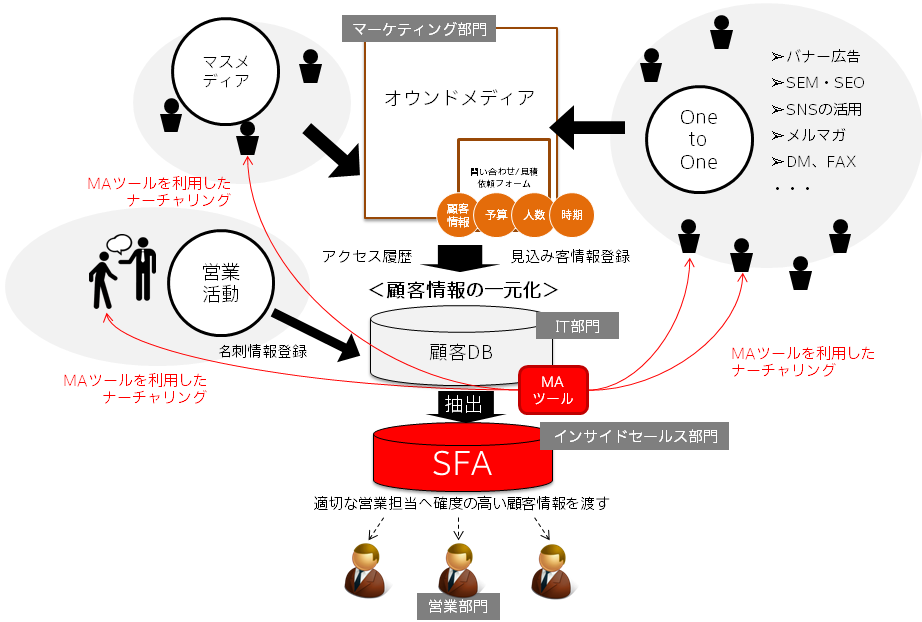Are you familiar with the terms "lead generation" and "lead nurturing"? "Lead generation" is a marketing technique for collecting information on potential customers with latent needs. "Lead nurturing" is a marketing technique that utilizes the collected prospect information to make those needs explicit. The difference from CRM is this: while CRM is a marketing technique that utilizes information from customers who have already made a purchase to turn them into loyal customers, "Lead Generation/Lead Nurturing" utilizes information from the prospect stage before they become customers to convert them into customers. (Some companies refer to the process of turning customers into loyal customers as Lead Nurturing).
Lead generation and lead nurturing are collectively referred to as "lead management." While these terms are familiar to companies focused on B2B marketing, they may still be relatively new concepts for companies primarily engaged in B2C marketing.
This is because B2B companies have direct sales interactions with prospects, enabling them to collect and utilize prospect information. Conversely, B2C companies, particularly manufacturers, often lack direct contact with prospects. They may even lack opportunities to collect prospect information, making the very concept of lead management difficult to implement. Furthermore, unlike the limited prospect information in B2B, leveraging the vast amounts of prospect data in B2C requires the power of IT, as discussed in previous articles. Building an in-house environment incurs enormous costs, but nowadays, cloud environments enable construction at reasonable prices, making lead management feasible for B2C companies.
Cloud Services Supporting Lead Management
The primary cloud services supporting this lead management are SFA (Sales Force Automation) and MA (Marketing Automation). Their roles within lead management are illustrated in the diagram below.

MA identifies potential customers with latent needs through "lead management," then sends this hot customer information to SFA, the sales activity support tool.
Recently, requests for SFA and MA implementation support have increased not only from IT vendors but also from advertising agencies like ours. The reason, I believe, lies in the expertise required for scenario design that supports the customer journey for nurturing prospects within MA. I will introduce MA in more detail next time.
SFA: Visualizing Marketing Effectiveness
SFA's core functions are diverse, including customer information viewing (covering prospects), sales process management, knowledge sharing, and communication between sales personnel.
Among these, the reason companies like ours are entrusted with SFA construction is likely because we can oversee the entire marketing strategy and operational design. This enables seamless lead management, as shown in the diagram above, from mass media campaigns all the way to handing over prospect information to sales representatives. Naturally, the overall design is crucial—from the SFA system, sales reps must be able to confirm the specific reasons why a prospect is hot: what products they showed interest in, how much interest they showed, and the nurturing journey that led to their handover to the sales rep.
For example, if a salesperson can know beforehand—with the prospect's consent—which vehicle pages they viewed on the website and how often before visiting the dealership, they can narrow down recommended models right from the start of the sales discussion. Automotive dealerships are an industry striving to shave minutes and seconds off each operational step to spend more time approaching more prospects. There's no doubt such efforts are highly beneficial.
Furthermore, because this SFA possesses sales process management functionality, the salesperson themselves inputs and manages the outcome information regarding whether the prospect made a purchase. As mentioned earlier, this means it becomes possible to manage the entire purchasing process, from mass media initiatives to the prospect's final purchase outcome.
Until now, establishing a PDCA cycle directly linking marketing initiatives to purchase outcomes was only achievable through e-commerce purchase histories. However, implementing SFA enables management of purchase histories from physical sales channels too, allowing for a more precise PDCA cycle. The internal data integration environment aimed at establishing this more refined PDCA cycle is precisely what we call a "Private DMP."
Moreover, SFA systems, which previously required extensive time and significant costs to build from scratch in-house, can now be launched through simple configuration rather than full-scale construction by leveraging cloud services. This lowered barrier to IT system implementation is perhaps the primary reason why not only IT companies, but also marketing firms and even advertising agencies can now provide value in this domain.
Next time, we'll discuss "marketing automation" tools for advertising agencies.



